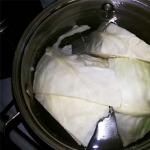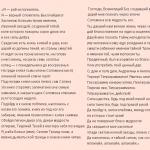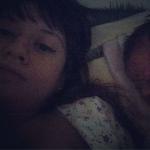A harmoniously designed space is based on certain rules that designers and decorators follow to ensure that the interior looks balanced and aesthetically pleasing. We intend to reveal for you the secret of successful decorative design of any surface in the room, be it a shelf, a console tabletop, a chest of drawers or a coffee table.
There are some rules that govern almost all the work of experienced specialists, and one of them is the “rule of three.” Its meaning lies in the relationship between the shapes, colors and sizes of objects collected in compositions of three, for example: a book, a vase, a figurine. It is believed that in this way we perceive the information picture more easily.
Let's look at examples of successful arrangement of objects into a single compositionRight:
The coffee table is decorated with three objects (a lantern, a vase with flowers and a decorative dish) of different shapes and sizes in relation to each other (large, smaller, smallest). In this composition, the objects look balanced, which cannot be said about the next example with the console.
1

Incorrect:
The composition on the console cannot be called successful, because none of the “rules of three” are observed: the objects hardly differ in color, size and shape, forming the same rectangles.
 1
1

In order for the compositions decorating the space of the room to look harmonious and interesting, it is important to use at least two of the three rules when arranging them, namely:
- Items of different sizes
The photo below shows a composition of decorative vessels of a similar shape, but obviously of different sizes, as well as with accessories of different colors (white, cream, turquoise) inside each.
The living trees on the dining table are combined according to the same principle: the shape of the pots is similar, but their shade and height of the plants are different.
 2
2

- Objects of different shapes
A composition for decorating a table or chest of drawers can be made up of three items of completely different shapes, as in the photo below. Here you see a combination of objects such as a framed photo (square), a table lamp (cylinder), and a stack of books with a figurine (triangle). The objects are of different sizes in relation to each other, but the color scheme is common for all (gold, black, white).

 1
1
- Multi-colored decor
You can create a harmonious composition from any decorative items, dear to your heart or simply whimsical and unusual. You can combine three items of completely different colors and different shapes, with a slight difference in their sizes.
 1
1
Perfection will be achieved by the one who manages to combine the decor, according to the “rule of three” at the same time, it may look like this:
- The console is decorated with objects of different heights and widthsThe mirror, vases and tray have different shapesWhite, red and gold colors are combined in one composition

- Three groups
Don’t be upset if you need to beautifully arrange a large number of decorative accessories, but you don’t know how to do it correctly.
To form an integral composition from numerous objects, you should first divide them into three equal groups, different in color, shape or size, and then, each of them again disassemble according to the same principle.
As an example, we will describe the option shown in the photo below:
- the composition is represented by three groups of objects of different sizes and shapes: vases, a picture in a frame, a lamp and a bowl
- the group on the left side consists of vases of different shapes, colors and sizes
- the group on the right is represented by a tall lamp, a lower bowl, and a tray (all objects of different colors and shapes)
 2
2
 1
1
Before you sign up for a mission to colonize Mars, get ready to say goodbye to the traditional bedroom concept. On space travel, the usual large bed with a thick mattress and a warm blanket is an unprecedented luxury. Every extra kilogram of cargo sent into space is incredibly expensive: and therefore engineers go to any lengths to make things intended for long-distance flights light, comfortable and functional. This applies primarily to the design of furniture and interior spaces in which the colonists will have to live on the Red Planet.
IKEA on MarsThe Utah Desert is a favorite place to simulate the Martian surface: the same ubiquitous sand and fine dust, rocky terrain, the same heat and dryness. The IKEA design team came here in three days to develop a unique home design that would be equally relevant both on another planet and on Earth.
As a result, it was decided to design the building in the form of a two-story “cylinder” 33 feet wide (a little more than 10 meters). One of the designers, Robert Janson, drew attention to the fact that in practice, while living in such a space, people begin to greatly value privacy. Classic furniture does not fit into it at all: for example, most of the space was occupied by bunk beds, which were used only for sleeping - so the useful space simply “idled” during the day.
This is what the experimental “Martian settlement” of IKEA designers looks like in the Utah desert
As a result, one of the team's consultants, Constance Adams, suggested starting with a simple concept: each object should have as many useful functions as possible - otherwise the colonists' mission would not be able to afford it. The designers have set the direction for a number of projects: these include beds that can be assembled, pushed into the wall and, if necessary, used only partially as cribs; and “virtual” windows, which will not only ensure the airtightness of the space, but will also become projectors showing videos with useful information or simply views of the native Earth, so that in conditions of isolation people do not develop depression.
Functionality comes firstIKEA is not the only one concerned about the space design of the future. Inspired by the fact that sending cargo to Mars would cost $2,600 per pound (0.45 kg), Swedish designer Thomas Misse came up with ultra-thin, foldable "Mars chairs" made from carbon fiber.
 Lightweight and durable “Martian” chairs
Lightweight and durable “Martian” chairs
Christina Liu from London has developed a collection of utilitarian clothes for space life. It includes, for example, a spacesuit in which you can take a shower, or a robe with a vacuum cleaning function. Of course, they are intended primarily not for commercial sale, but as demonstration models that remind people that even in the simplified and meager life of space colonists there can be a place for comfort.
NASA also did not stand aside and asked architectural firms to think about what kind of buildings could be erected in the conditions of the Red Planet. Some of the ideas presented in the special 3D-Printed Habitat Challenge look like luxury cabins on a ship. The first place was taken by the Mars Ice House project - a unique four-story igloo (Eskimo dwelling), with a spiral staircase and a complex of private and public premises. Rooms with curved walls, according to the authors, are necessary primarily to create the illusion of large space.
But, of course, all these concepts will be of no practical use if the tools and materials needed to build them do not meet the stringent technical requirements for space travel. Moreover, most of them must remain in working order both in conditions of weightlessness and in Martian microgravity (equal to approximately 1/3 of Earth's). And the interiors of the ship itself, if necessary, should be able to be used as tables, chairs and other components of the environment for work and living.
World of materialsIn terms of components, furniture on Earth is also very different from prototypes designed for space travel. Plastics and synthetics commonly used on Earth can emit toxic fumes, which are especially dangerous in oxygen-poor environments. Oddly enough, but, according to experts, natural materials are much better suited for interior decoration: wool, wood and leather are the colonizer’s choice.
 House for Martian colonists according to the Mars Ice House project
House for Martian colonists according to the Mars Ice House project
Philipp Sussman, one of the designers at IKEA, notes that people tend to have a much stronger emotional attachment to the things they have assembled with their own hands. For example, the Round Table in King Arthur's castle is not just symbolic, but also a very successful piece of furniture from the point of view of psychological comfort. As in his case, furniture for colonialists should be designed in such a way as to give each expedition member the most equal and comfortable conditions in comparison with others. Another problem that residents of Martian settlements may encounter is a high level of noise, and therefore closer proximity during negotiations will facilitate communication, allowing the interlocutors to better read each other’s lips.
ConclusionUltimately, all these projects may be useful not only for Mars, but also for the inhabitants of Earth. The same design ideas will help us save space on our home planet (which, given the ever-increasing population of people, will be a very smart step), and the use of modern and non-toxic materials will improve the environmental situation.
In November, Quanta magazine puzzled its readers with questions about making shapes from identical flat objects (such as coins or dominoes). This article provides both questions and detailed answers to them.
Question 1In the classic problem of constructing an overhanging figure, all blocks must be homogeneous, identical in size and shape, and their length is taken as one. There can only be one block at each level of the figure. Blocks cannot be connected or glued together. If you have five of these blocks, what is the maximum length that the end of the top block can extend beyond the edge of the table on which they are lying? Can you derive the formula for maximum overhang when using n blocks?
Physically, the problem requires balancing the torque of the figure on both sides of the edge of the table. The torque of each side is found by the product of the mass of that side and the distance from the center of mass to the edge. When the center of mass of the entire figure is above the edge, the same moment is exerted on both sides of the figure, and the total torque of the system is zero. For a composite object, the total torque for any face can be found by adding the torques of all the component parts. Therefore, we can divide and conquer the original problem by considering only the changes that occur when a new block is added to an existing stack, something like mathematical induction (let's call it physical induction).
Consider a stack of n-1 blocks, each weighing one unit of weight and having a length of one unit of length. The stack is balanced on the edge of the table. Imagine that your line of sight is along the edge of the table, and the table is to the left - that is, the overhanging ends of the blocks are protruding to the right. Because the stack is balanced at the edge, its center of mass is directly above the edge and its torque is zero. Now imagine that we lifted the entire stack vertically, and placed another block underneath it so that its right edge was flush with the edge of the table. This may be difficult in practice, but in a thought experiment it is simple.
We added some stability to the stack by adding the nth block at the bottom, as the center of mass of the entire stack shifted slightly to the left. Let's denote this displacement x. n blocks weigh n units, and they have a total torque x*n around the edge of the table, directed to the left. Recall that a stack of n-1 blocks has a total moment of zero. We added only the moment of a new block - with a mass of one mass unit and with a distance to the center of mass from the edge of the table of half a unit of length.
It turns out that x*n = 1/2, which means x = 1/2n, where x is the distance to the new center of mass from the edge of the table.

This means that if you shift the entire stack of n blocks to the right by 1/2n the length, it will be perfectly balanced on the edge - and that's the maximum possible shift. To complete the construction of induction, we note that the maximum overhang of the first block from the edge of the table is 1/2 a unit of length.
Therefore, for five blocks, we substitute n into the formula for each level from 1 to five to get the maximum overhang:
x=1/2+1/4+1/6+1/8+1/10=137/120=1.141(6)
You can see that if you start at the top and then add blocks down, each shift will be half the inverse number of blocks available. Such sequences of reciprocal numbers are known as harmonic series. Such a series slowly diverges, and as n tends to infinity, it also tends to infinity.
The general sum formula for n blocks is obtained by summing all terms of the series. This produces half of the nth harmonic term, which can be written as:

Imagine that you have the same five blocks, and you want to put some kind of decoration on the topmost one, at a point a quarter of the length of the block from the hanging end. All blocks weigh one unit of weight, and the decoration weighs one fifth of the block. What is the maximum overhang length now? How does this change the basic formula?
First, consider the first block with the decoration standing on it and lying so that its right edge is flush with the edge of the table. The center of mass of the block without decoration is half a unit length from the edge of the table. The decoration will move it to the right by, say, x. The mass of the decoration is 1/5, and its distance from the new center of mass will be 1/4. Let's equate the moments and get x = 1/5*(1/4-x), therefore, x = 1/24. Because of the decoration, it is necessary to move the first block to the left by 1/24 of the length, so the maximum overhang is now 11/24 instead of 1/2.

For subsequent blocks, you can apply the same induction as in the first question. We get the equation x(n+1/5) = 1/2, which for n blocks simplifies to 1/2(n+1/5). This gives us the sequence 1/24 + 5/12 + 5/22 + 5/32 + 5/42..., which results in a maximum overhang of 1.057 for a five-level figure. Note that the overhang of the first block does not fit into the overall scheme due to the additional weight of the decoration. However, a simple harmonic sequence emerges through which the final sum can easily be calculated.
Question 3Imagine you are competing against a friend in a game where you have to create overhanging structures. First you have one block at a time. You place your blocks with any overhang from the edge of the table. You are then given a random but equal number of additional blocks from one to four. Each turn begins with an initial block as a base, the position of which cannot then be changed, and with an additional set of one to four blocks. How far do you need to move the original block over the edge of the table so that you have the largest possible overhang after a large number of moves?
Since the probability of having two to five blocks is the same, you need to maximize the sum representing the maximum overhang for these four cases. For a stack of 2-5 blocks, there is an optimal position for the first block that gives the maximum overhang of the entire stack. If you plot the largest overhang for each of the four possible sizes of the next stack, you will get two line graphs and two inverted V graphs. Their vertices indicate the optimal starting position of the initial block for stacks of 3-4 blocks. Having summed up the graphs, we obtain a general graph of the overhang, sharply changing direction in each of the four optimal positions. It turns out that the best overall overhang is achieved at the optimal position for three blocks, after which the graph goes down. Therefore, you need to position the original block on the assumption that you will be given three additional blocks, and the overhang will be 1/6 of the length unit.

Readers have pointed out several limitations that prevent this hypothetical mathematical bridge from extending into infinity: wind, unevenness, lack of infinite precision, elasticity or insufficient hardness of the blocks and table, etc. This is, of course, correct. To this we can add the curvature of the Earth and the absence of infinite space. Which of these constraints will collapse our stack the fastest? To answer this question, it is useful to study the adjacent one: if you forget about overhangs from the edge and just stack Jenga blocks on top of each other, there is no mathematical limit on the height of the tower. But it will be destroyed by small imperfections in the blocks and inaccuracy in their construction, and vibration or wind will play the role of the last straw. The same is true for our hanging figure. If you adjust for all of these factors, at some point the stiffness of the blocks will come into play, when the lower blocks will bend a little and move away from the horizontal due to the combined torque of all the blocks above, which will lead to the upper blocks slipping.
I mentioned that the greatest overhang can be achieved by allowing several blocks to be used on the same level. As several readers have noted, the optimal solution to this problem is described in the 2009 paper Maximum Overhang, by Paterson, Peres, Thorup, Winker and Zwick. To me, small structures made using the Paterson-Zwick method remind me of a kingfisher. The big ones look like magic lamps. For an overhang of two units of length, these schemes are 2-3 times more efficient than classical harmonic overhangs, and achieve such an overhang using 14 blocks instead of 32. Unfortunately, their mathematics is too complex for this article.

What do you think, if you divide half a hundred by half, how much will you end up with?
Answer
What sign do you think should be placed between 0 and 1 to get a number greater than 0 but less than 1?
Answer
How many edges do you think a hex pencil has that has never been sharpened?
Answer
A three-liter vessel is completely filled with three liters of water. You need to fill two empty vessels of 1 and 2 liters in 2 transfusions, so that each of them contains 1 liter of water. In this case, you can no longer use anything other than these three vessels.
Answer
Do you think there are lines other than a circle on which all points are equidistant from one point?
Answer
Which object do you think will have the same image when drawn from any point of view?
Answer
Try to figure out which of the following conclusions is correct:
A) There are three false conclusions here.
B) There is one false conclusion here.
C) There are two false conclusions here.
D) There are five false conclusions here.
D) There are four false conclusions here.
Answer
Try to guess how much a book costs if a book costs a dollar plus half a book.
Answer
Answer, what time is it now if the remaining part of the day is twice as long as the past?
Answer
5 fishermen ate 5 carp in 5 days. What do you think, in how many days will 15 fishermen eat 15 carp?
Answer
There are 9 kg of sugar in the bag. There are also two weights of 50g and 200g. Think about how to weigh 2 kg of sugar in three weighings on a cup scale?
Answer
Two collective farmers decided to find out who has more sheep. The first of them said: “If you give me your goat, then I will have twice as many as you.” The second one says to him: “It’s better if you give me your one sheep, then I will have as many sheep as you.” How many sheep does each collective farmer have? (There has been no transfer of sheep yet).
Answer
There are only 36 students in one class. There are 3 more girls than boys. How many boys and girls are there in this class?
Answer
Can you write the number 1000 using only eight eights and arithmetic sum signs?
If you multiply three tens by four tens, how much do you get?
Answer: The result will be not 12 tens, but 120 tens. That is: 30 * 40 = 1200.
Can you justify why in almost all countries of the world sewer manhole covers are only round in shape? (Square manhole covers are available only when they are additionally secured with hinges).
Answer: If the manhole covers are square, they can easily fall into the manhole, because... The diagonal of a square is greater than the side of the square.
Therefore, if they are made, then only by attaching them to the hatch with hinges.
Round hatch covers do not have a diagonal or a side, but only a diameter, which is always larger than the hatch opening.
What sign do you think should be placed between 0 and 1 to get a number greater than 0 but less than 1?
Answer: This character is a comma. That is 0.1. This number is greater than 0 but less than 1.
How many edges do you think a hex pencil has that has never been sharpened?
Answer: A hex pencil, if not sharpened, will have 8 edges. 6 large edges and 2 end faces.
A three-liter vessel is completely filled with three liters of water.
You need to fill two empty vessels of 1 and 2 liters in 2 transfusions, so that each of them contains 1 liter of water.
In this case, you can no longer use anything other than these three vessels.
Answer: From a full vessel we pour exactly two liters into a two-liter empty one, i.e. to the brim.
Next, pour exactly a liter of water from this vessel into a one-liter container (i.e., to the brim).
Do you think there are lines other than a circle on which all points are equidistant from one point?
Answer: Any line lying on the surface of the ball is equidistant from all points.
Which object do you think will have the same image when drawn from any point of view?
Answer: Only the ball has this property.
Try to figure out which of the following conclusions is correct:
A) There are three false conclusions here.
B) There is one false conclusion here.
C) There are two false conclusions here.
D) There are five false conclusions here.
D) There are four false conclusions here.
Answer: The correct option is D - there are four false conclusions here. Due to the fact that one is true and the rest are not true.
Try to guess how much a book costs if a book costs a dollar plus half a book.
Answer: The book costs 2 dollars. Solution: half a book costs a dollar, so the whole book costs 2 dollars.
Answer, what time is it now if the remaining part of the day is twice as long as the past?
Answer: It’s eight o’clock now.
A businessman wanted to bring 10,000 pairs of high-end, expensive sneakers to Japan to sell.
But in Japan, very high duties are imposed on such sneakers.
Think and tell me how a cunning businessman was able to import all these sneakers to Japan,
and only paid very little money? There is no corruption or criminal component here.
Answer: The businessman acted very cunningly. He separated each pair of sneakers and sent the entire volume in two shipments.
That is, in one batch there were only sneakers for the left foot, in the second only for the right foot. He sent one batch to Tokyo, the other to Osaka.
In each city, the businessman did not pay the duty and the goods were confiscated and put up for auction.
Due to the fact that no one needed a batch of sneakers for only one foot, the businessman bought both batches himself for meager money.
5 fishermen ate 5 carp in 5 days. What do you think, in how many days will 15 fishermen eat 15 carp?
Answer: 15 fishermen will eat 15 carp in 5 days. If 5 fishermen eat 5 carp in a certain period of time,
then 15 fishermen have a rate of eating carp that is 3 times higher, therefore in 5 days they will eat 15 carp.
There are 9 kg of sugar in the bag. There are also two weights of 50g and 200g.
Think about how to weigh 2 kg of sugar in three weighings on a cup scale?
Answer: First, you need to use a cup scale to divide the contents of the bag in half into 4.5 kg in each cup.
Next, we empty one bowl, and again divide 4.5 kg in half and get 2.25 kg in each bowl of the scale.
During the third weighing, you need to empty both bowls, but put 2.25 kg of sugar from one bowl into a separate bag.
And then, using 200g and 50g weights (total 250g), weigh out exactly 250g from the 2.25kg bag. Then there will be exactly 2 kg left in the bag.
Two collective farmers decided to find out who has more sheep.
The first of them said: “If you give me your goat, then I will have twice as many as you.”
The second one says to him: “It’s better if you give me your one sheep, then I will have as many sheep as you.”
How many sheep does each collective farmer have? (There has been no transfer of sheep yet).
Answer: The first collective farmer has 7 sheep, the second only 5.
If the first collective farmer gives one sheep to the second and they become equal, it means that initially the first one has 2 more.
If the second collective farmer gives the sheep to the first, then the first one has 2 times more of them, this is possible,
only if the first one initially had 7 sheep, and the second one 5.
There are only 36 students in one class. There are 3 more girls than boys. How many boys and girls are there in this class?
Answer: If we divide 36 in half, we get 18, i.e. two halves of a class of 18 people each.
If you add a student from the first half to the other, you get a difference of 2 people.
If we subtract one more and add it back to the larger part, we get an excess of 4 people. Therefore the problem has no solution.
Can you write the number 1000 using only eight eights and arithmetic sum signs?
Answer: The result is equality: 888 + 88 + 8 + 8 + 8 = 1000.
There are 4 coins on the table, one of which is made of a different metal and differs in weight, although outwardly they are all the same.
How to determine this coin after 2 weighings on a cup scale?
Answer: Weighing options: 1) put 1 and 2 coins on the scales, if they are equal in weight, then replace one coin with a third.
Further, if they are equal, then the 4th coin is different, if they are not equal, then the 3rd coin is different from the rest. 2) put 1 and 2 coins on the scales, if they are not equal in weight,
then instead of one coin we put a third one. If they balance, then an excellent removed coin; if they do not balance, then
then the old coin remaining on the scales is different from other coins.
How could it be that half the number 12 became equal to 7?
Answer: You need to write the number 12 in Roman numerals: IIX, then draw a line in the middle. The top half will be in the form of VII, which corresponds to the number 7.
There are 7 candles burning on the festive table. 3 of them were extinguished. How many candles will be left?
Answer: There will be 3 extinguished candles left, because... the remaining 4 will burn completely.




















